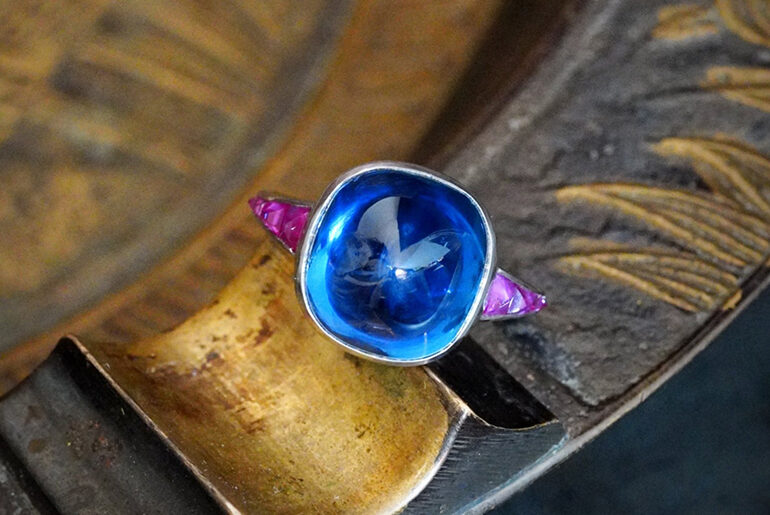These stones and minerals traveled for eons across the galaxy, eventually crashing on our planet and enabling us to enjoy their beauty.
We know of many different minerals, gemstones and metals that appear in nature. Some formed millions of years ago during various geological, physical and chemical processes. However, there are a few that one could, without exaggerating, call alien species — stones that arrived as passengers aboard meteorites and impactites that collided with our planet thousands or even millions of years ago.
How do we know? First of all, these gems have properties that tell us they could not have formed naturally in our environment. In addition, they show up only in specific places in the world and nowhere else, suggesting that the deposits resulted from a celestial body landing in those spots. In the last several decades, scientific examination has confirmed many of the theories that place the origin of these rare stones in outer space.

Peridot meteorites
Peridot — also known as olivine, an iron and magnesium silicate — can be found in many countries, usually forming in lava. However, the mineral also appears in astronomical bodies throughout our solar system.
When peridot-bearing meteorites — specifically pallasites, or stony-iron meteorites — land on Earth, the intense heat from their journey and the explosive effects of their impact mean not many of the olivine specimens survive intact. As a result, peridot pieces from outer space tend to be small.
Researchers at the Gemological Institute of America (GIA) tested 26 such peridot samples to determine the differences between them and their terrestrial counterparts, and shared their findings in the Fall 2011 issue of Gems & Gemology. As it turned out, the two varieties showed different levels of lithium, vanadium, nickel, manganese, cobalt and zinc.
Due to their rarity, peridots from outer space are significantly more expensive, so being able to distinguish them is helpful for gemologists and jewelers.

Opals from Mars
Several years ago, scientists studying a Martian meteorite that had landed in the early 20th century made a surprising discovery: The rock contained samples of fire opal, an opal variety that has been known to trap microbes here on Earth. If it did the same on Mars, the researchers reasoned, this could be a promising lead in the search for life on the red planet.
On Earth, fire opals form around the chemically rich hydrothermal vents on the sea floor. As the rock interacts with the seawater during the formation process, it can trap the microbes that tend to thrive in this environment.
While prior analyses had suggested the presence of opal on the surface of Mars, the Nakhla meteorite — named for El Nakhla el Bahariya, an Egyptian village near the space rock’s 1911 impact site — offered proof that the gem could indeed form there and may have preserved Martian microorganisms from millions of years ago, according to a 2015 report.

Carbonado diamonds
Also known as black diamonds, carbonados are among the toughest of natural diamonds. There are several theories as to their origins, with the most common suggesting that they form similarly to regular diamonds: from organic carbon under high-pressure conditions in the earth’s interior. On the wilder end of the spectrum, there are those who posit that they come from carbon-based alien life forms that may have inhabited a far-off planet.
However, there is support for a somewhat more moderate theory of carbonados’ extraterrestrial origins: that they resulted from a distant supernova nearly 4 billion years ago.
In a 2006 paper, researchers Jozsef Garai, Stephen Haggerty, Sandeep Rekhi and Mark Chance pointed to the presence of hydrogen in these stones as an indication that they came from hydrogen-rich interstellar space, building on earlier findings by Haggerty that suggested they had formed in supernova explosions.
Adherents of this theory believe the particles coalesced and then drifted through space until our sun’s gravity drew them in and sent them crashing to earth as a meteorite. The rock then fragmented on entry, landing in what would become Brazil and the Central African Republic — the primary locations of carbonado diamond deposits today.

Moldavite (Vltavin)
Moldavite, with its distinctive olive-green color, was first discovered in 1787 by Josef Mayer, a professor at Charles University in Prague. At the time, he thought the stones were just chrysolites of a similar color. But in the 20th century, researchers posited that they had actually been formed during a meteorite strike about 14.7 million years ago. The meteorite in question landed in what is today central Europe, creating the Ries crater, which spans about 24 kilometers in diameter in south Bavaria, the southern Czech Republic and northern Austria.
Some moldavite stones even carry marks of their flight through the atmosphere, such as aerodynamic curves and microscopic bubbles with very low air pressure in them.
These glassy gems can be found around the Vltava River and are therefore known as “Vltavin” in Czech. Because of moldavite’s high value, Czech police often guard these areas to prevent unofficial diggers from plundering the land during the night with picks and shovels.
In the south of the country, moldavite is part of local tradition: When a young man wanted to ask for a girl’s hand in marriage, he would give her family a Vltavin stone to express his commitment.
Edited by Rachel Beitsch-Feldman.
Main image: Montage by David Polak.





4 Comments
Right now it appears like Movable Type is the best blogging platform out there right now. (from what I’ve read) Is that what you are using on your blog? Here is my page:
It’s an remarkable post designed for all the online people; they will obtain benefit from it I am sure. Also visit my homepage
Hi, all is going sound here and ofcourse every onne iis sharing information, that’s genuinely excellent, keep up
writing. https://mostbet-casino.mystrikingly.com/
Hi, always i used to check webpage posts here early in the dawn, for the reason that i like tto learn more and more. https://peoplepressus.com/139409